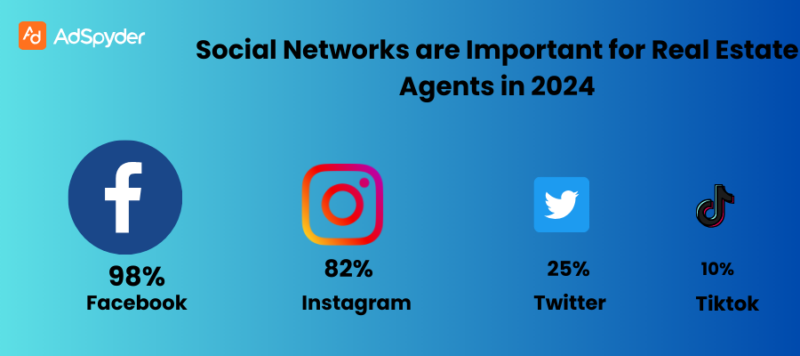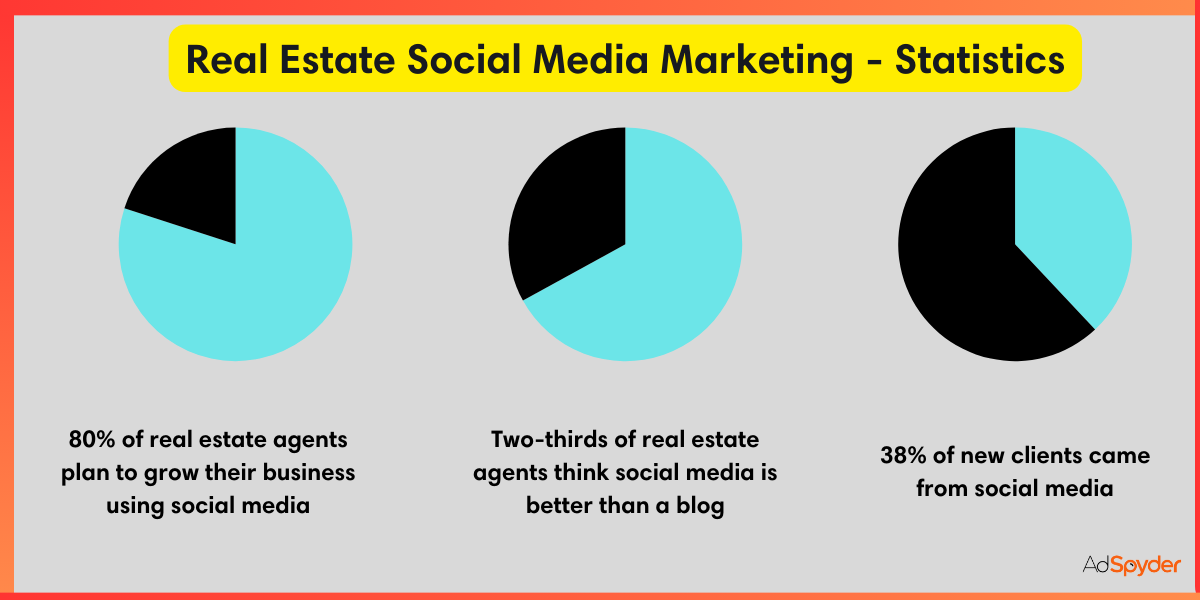Real estate marketing can be a game changer for those who are in this industry. Today, using Facebook and Instagram is a must for success. “Amplifying Success: Mastering Social Media Ads for Real Estate Growth” is your guide to effective digital marketing. We’ll explore creating eye-catching ads, engaging buyers, and building a strong online presence when it comes to engaging real estate ads. Read more to learn and explore the art of social media ads for real estate prosperity in the digital age.
Understanding the Social Media Landscape for Real Estate
Explore real estate marketing in the digital age with “Amplifying Success.” Use Facebook and Instagram for growth. Learn to make interesting ads, show off properties, and be strong online. This is your opportunity to become great at social media ads for real estate success.
In today’s generation, social media has become an invaluable tool for real estate professionals to connect with potential buyers and sellers. Let’s delve into this digital landscape and explore its benefits for the real estate industry.
Key Platforms for Real Estate Advertising

For showcasing properties and reaching a wider audience, real estate professionals turn to key social media platforms such as Facebook, Instagram, and Twitter–all popular choices.
On Facebook, you can create dedicated business pages where you can share property listings, offer insights about neighborhoods, and engage with your community.
Instagram, with its visually appealing nature, allows you to showcase eye-catching property photos and videos, capturing the attention of potential buyers.
Twitter, on the other hand, is ideal for real-time updates and quick announcements about new listings.
Demographic Targeting on Social Media
One of the most powerful features of social media advertising is its ability to target specific demographics. Real estate professionals can customize their content to reach the right audience. For example, if you have a family home for sale, you can target your advertising towards families with children. This targeted approach ensures that those who are most likely to be interested in what you have to offer see your message.
By using demographic targeting, you can refine your marketing strategy and make the most out of your advertising budget. It’s like having a direct conversation with people who are actively searching for a home just like yours. This personalized approach increases the chances of attracting serious inquiries from potential buyers.
Watch out: Mastering the Market: Proven Paid Advertising Strategies for Real Estate Agents
Crafting Compelling Real Estate Ads on Social Media

With real estate, creating ads on social media that truly capture attention and attract potential buyers is crucial. A compelling ad content uses engaging visuals, concise descriptions, and attention-grabbing headlines. Discover how these crucial elements can have a profound impact on establishing an online presence.
Designing Visually Stunning Ad Content
The first step in making your real estate ads stand out is to focus on visually appealing content. Think of your ad as a window into the property you’re selling.
Utilize high-quality photos that showcase the best features of the home – whether it’s a spacious living room, a modern kitchen, or a beautiful backyard. Keep your images clutter-free; simplicity often speaks louder than complexity.
Consider incorporating a slideshow or a short video tour to provide viewers with a dynamic and immersive experience. This allows potential buyers to get a sense of the property and visualize themselves living there. Remember that many people scroll quickly through their social media feeds, so make sure your visuals are captivating enough to make them pause and take a closer look.
Crafting Engaging Ad Copy
While captivating visuals are essential, the words you use in your real estate ad also play a crucial role.
Your ad copy should be concise, clear, and compelling. Start with an attention-grabbing headline like “Discover Your Dream Home!” or “Experience Picture-Perfect Family Living.” This sets the tone for the rest of your ad.
In the main body of your ad, focus on highlighting the unique selling points of the property. Showcase key features and amenities that make it special. Use simple language to describe its benefits – whether it’s its convenient location, ample storage space, or recently renovated interior. Avoid using jargon or complex terms; aim for accessibility to reach a wide audience.
Include a call-to-action that encourages viewers to take action. Whether it’s visiting your website for more information, scheduling a showing, or contacting you directly, guide potential buyers on what steps to take next.
A clear and inviting call to action can make all the difference in turning someone who admires your ad into someone who actively engages with your real estate listing.
By keeping it simple, clear, and inviting, you increase the chances of transforming a casual scroll-by into a serious inquiry – bringing you closer to connecting the right buyer with their perfect property.
Leveraging Facebook for Real Estate Marketing
Real estate Facebook marketing stands out as a powerful tool for connecting with potential buyers. With millions of people using Facebook right now, it is easy for advertisers to connect with those whose interests align and match with yours. To begin with, regular posting, timely responses to inquiries, and utilizing Facebook’s advertising analytics help refine strategies and maximize ROI.
Harnessing Facebook’s Precision Targeting Capabilities
Facebook’s precision targeting capabilities offer endless possibilities for real estate professionals. You can precisely tailor your ads to reach specific groups of people who are most likely to be interested in your listings.
One remarkable feature is demographic targeting. This means you can narrow down your audience based on factors such as age, location, interests, and even life events.
If you have a cozy apartment ideal for young professionals, you can direct your ads towards this specific group. It’s like engaging in conversations with individuals already inclined towards what you’re offering.
Additionally, Facebook allows you to create custom audiences. This feature enables you to target people who have already shown interest in your properties or have visited your website.
Measuring and Optimizing Ad Performances
Once you have your ads up and running, it’s important to evaluate their performance to ensure you’re getting the most out of your efforts. Facebook provides valuable insights and analytics that allow you to assess how well your ads are doing. You can track metrics such as reach, engagement, and click-through rates.
Understanding these metrics helps you identify what’s working effectively and what areas might need improvement. For example, if you notice a high engagement rate on a specific type of ad, it would be beneficial to focus more on creating similar content.
On the other hand, if a particular ad is not performing as expected, consider making adjustments to the visuals or ad copy for better results.
Optimizing ad performance requires some experimentation. Don’t be afraid to try different ad formats, headlines, or images to see what resonates best with your audience.
Facebook’s ad platform allows you to conduct A/B tests with various elements, which helps refine your strategy over time.
To put it simply, measuring and optimizing ad performance involves adjusting and refining until you find the right combination that captures the most attention and engagement.
Maximizing Instagram Ads for Real Estate Exposure

The real estate industry is based on visual appeal and Instagram is a platform driven by visually appealing content, making it one of the precise platforms to showcase your properties and listings. To make the most out of your Instagram ads for real estate, there are a few strategies that you can incorporate which can range from creating creative ad copies and using a variety of ad formats.
Creative Strategies for Instagram Ad Campaigns
Instagram revolves around visuals; therefore, crafting visually appealing ads that grab attention is crucial. Start by selecting high-quality photos and videos of your properties.
Highlight the best features such as spacious living rooms, modern kitchens, or scenic views. Think of your ad as a glimpse into the lifestyle that a property can offer.
Consider using Instagram Stories to tell a story about your listings. A series of photos or short videos can provide viewers with a virtual tour, allowing them to envision themselves in the space.
Keep it simple and authentic – a genuine look into the property can be more compelling than overly polished content.
Another creative approach is using carousel ads, where users can swipe through multiple images within a single post.
This is an excellent way to showcase different rooms, amenities, or aspects of a property cohesively.
Engaging with the Instagram Community
Beyond displaying your listings, engaging with the Instagram community plays a vital role in successful real estate marketing on this platform.
Respond to comments on your posts, reply to direct messages, and interact with other users in your niche. Building an authentic online presence fosters trust and credibility among potential buyers.
Strategically use hashtags to increase the discoverability of your posts. Research and include relevant hashtags related to real estate, local communities, and property features. This way, users searching for specific terms or browsing related content are more likely to come across your listings.
Consider collaborating with local influencers or businesses to expand your reach. These partnerships can introduce your properties to new audiences and add authenticity to your brand. It’s like having a trusted friend recommend your listings to their followers.
Instagram also provides sponsored ad options that allow you to reach users beyond your current followers. Utilize the platform’s targeting features by focusing on specific demographics, interests, and locations.
This targeted approach ensures that your ads reach individuals who are more likely to be interested in what you have to offer.
Maximizing exposure for real estate on Instagram requires implementing creative strategies that showcase your listings and actively engage with the Instagram community. By combining visually captivating content with authentic interaction, you can establish a strong online presence, attracting potential buyers and transforming Instagram into a valuable tool for your real estate marketing endeavors.
Integrating Social Media Ads into an Extensive Marketing Plan
Integrating social media ads into a comprehensive strategy can significantly enhance your reach and impact. Let’s explore how this integration can create synergy with other marketing efforts and understand the crucial role that budget allocation and ROI considerations play.
Synergy with Other Marketing Efforts
The beauty of incorporating social media ads into your overall marketing plan lies in the harmony it creates with other promotional activities. Consider your website, for example – sharing the same visuals and messaging across social media platforms and your website establishes a consistent brand image. This synchronization reinforces your message and fosters a stronger connection with your audience.
Collaborating with influencers or local businesses is another effective way to amplify your marketing efforts. Whether it’s coordinating social media ads with influencers’ posts or seeking shout-outs from local businesses, this collaborative approach expands your audience. It’s like creating a unified choir where different voices harmonize to amplify the message.
Furthermore, don’t forget to integrate your social media handles into traditional marketing materials such as brochures, business cards, or even signage. This cross-channel promotion encourages potential clients to explore your online presence, creating a seamless transition from the physical world to the digital realm.
Budget Allocation and ROI Considerations
Effectively integrating social media ads into your marketing plan requires careful consideration of budget allocation and a keen eye on return on investment (ROI). Start by defining a clear budget specifically dedicated to social media ads that aligns with your overall marketing objectives.
Understand the unique strengths of each social media platform and allocate your budget accordingly. If your target audience is more active on Instagram, consider focusing a significant portion of your budget there. However, it’s important not to overlook the potential benefits of diversification – allocating funds to multiple platforms can expand your reach and engagement.
When it comes to ROI, regularly monitor and analyze the performance of your social media ads. Most platforms provide detailed analytics that showcase metrics such as engagement, click-through rates, and conversion rates. Utilize this data to identify what’s working well and where adjustments are needed.
Navigating Challenges and Ensuring Compliance
Overcoming challenges head-on and staying compliant with regulations are crucial aspects of advertising real estate on social media which directly leads to a successful marketing strategy. This contributes towards a credible and trustworthy online presence while also maintaining a positive reputation in the market. Here’s how to overcome common social media advertising challenges and ensure compliance with advertising regulations.
Overcoming Common Social Media Advertising Challenges
Social media advertising comes with its fair share of hurdles, and understanding how to overcome them is key to running a thriving campaign. One common challenge is keeping up with the constant changes in algorithms and features on platforms like Facebook and Instagram.
To tackle this challenge, stay informed about updates and be flexible in adapting your strategies. Think of it as navigating through a dynamic city – always ready to take a new route to reach your destination.
Another challenge is standing out amidst overwhelming competition for attention. With numerous ads flooding users’ feeds, capturing their interest becomes paramount. Craft visually appealing content that resonates with your target audience. It’s like being in a crowded marketplace – make sure your stall stands out to draw in potential customers.
The issue of ad fatigue is also prevalent, where audiences become tired of seeing the same ads repeatedly. Combat this by regularly refreshing your ad content and experimenting with different formats. Imagine it as changing the display in a storefront window to keep passersby intrigued.
Ensuring Compliance with Advertising Regulations
When it comes to advertising, staying compliant with regulations is not just the right thing to do, but it’s also crucial for establishing trust with your audience. Different platforms and regions have their own specific rules, and violating them can have serious consequences. To make sure you’re following the guidelines, take the time to familiarize yourself with the rules of each social media platform you use.
One important aspect of compliance is clearly disclosing any sponsored content, partnerships, or compensation. Transparency is key in building trust – think of it as having an open and honest conversation with your audience.
Respecting privacy laws is also essential, especially when targeting specific demographics. It’s important to understand the data protection regulations that apply to your target audience and ensure that your advertising practices align with these standards. Just like respecting personal space fosters a positive relationship, acknowledging boundaries in advertising shows that you value your audience’s privacy.
In addition, it’s crucial to avoid deceptive practices or false claims in your ads. Providing accurate information builds credibility and helps you steer clear of potential legal issues. Imagine presenting your product or service honestly, like a reliable friend who offers straightforward advice.
To stay compliant with changing regulations, it’s important to regularly review and update your ad content. Just as laws evolve over time, so should your advertising approach.
Conclusion
To succeed in real estate on social media, use a smart approach. Make eye-catching ads on Facebook and Instagram, connect with your audience, and showcase properties well. Blend these efforts with websites, influencers, and various channels for a consistent brand. Engage genuinely by using Stories and other features. Adapt to challenges like algorithm changes and fierce competition. Follow advertising rules for trust and fairness, like disclosing sponsored content.



